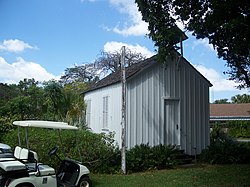
Miami, officially the City of Miami, is a coastal metropolis in the U.S. state of Florida and the seat of Miami-Dade County in South Florida. It is the core of the much larger Miami metropolitan area, which, with a population of 6.14 million, is the second-largest metropolitan area in the Southeast after Atlanta, and the ninth-largest in the United States. With a population of 442,241 within its city limits as of the 2020 census, Miami is the second-most populous city proper in Florida after Jacksonville. Miami has the third-largest skyline in the U.S. with over 300 high-rises, 58 of which exceed 491 ft (150 m).

Coconut Grove, also known colloquially as The Grove, is an affluent and the oldest continuously inhabited neighborhood of Miami in Miami-Dade County, Florida. The neighborhood is roughly bounded by North Prospect Drive to the south, LeJeune Road to the west, South Dixie Highway and Rickenbacker Causeway to the north, and Biscayne Bay to the east. It is south of the neighborhoods of Brickell and The Roads and east of Coral Gables. The neighborhood's name has been sometimes spelled "Cocoanut Grove" but the definitive spelling "Coconut Grove" was established when the city was incorporated in 1919.

George Edgar Merrick was a real estate developer who is best known as the planner and builder of the city of Coral Gables, Florida in the 1920s, one of the first major planned communities in the United States.
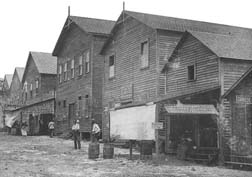
Thousands of years before Europeans arrived, a large portion of south east Florida, including the area where Miami, Florida exists today, was inhabited by Tequestas. The Tequesta Native American tribe, at the time of first European contact, occupied an area along the southeastern Atlantic coast of Florida. They had infrequent contact with Europeans and had largely migrated by the middle of the 18th century. Miami is named after the Mayaimi, a Native American tribe that lived around Lake Okeechobee until the 17th or 18th century.

Arch Creek was an early settlement in Miami-Dade County, Florida, in present-day metropolitan Miami. Tequesta Indians thrived here before the first Europeans arrived in the early 16th century. The name is derived from the 40 feet (12 m) long natural limestone bridge that spanned the creek until 1973. It is part of the Arch Creek Memorial Park at 1855 Northeast 135th Street, on Biscayne Boulevard. It was added to the U.S. National Register of Historic Places on July 15, 1986.

The Barnacle Historic State Park is a 5-acre (2.0 ha) Florida State Park in the Coconut Grove neighborhood of Miami, Florida at 3485 Main Highway.
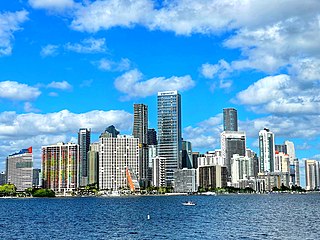
Brickell is a neighborhood in Miami, Florida, historically referenced at times as Southside, located directly east of Interstate 95, south of the Miami River and north of Coconut Grove. Brickell is known as the financial district of Miami, as well as South Florida.

The MacFarlane Homestead Historic District is a U.S. historic district located in Coral Gables, Florida. The district is bounded by Jefferson Street, Frow Avenue, Brooker Street and Grand Avenue. It contains 32 historic buildings.

El Jardin is a house located at 3747 Main Highway in Miami, Florida. It is listed on the U.S. National Register of Historic Places. El Jardin is now home to Carrollton School of the Sacred Heart in Miami, Florida. It was added to the U.S. National Register of Historic Places on August 30, 1974.

Redland, long known also as the Redlands or the Redland, is a historic unincorporated community and agricultural area in Miami-Dade County, Florida, located about 20 miles (32 km) southwest of downtown Miami and just northwest of Homestead, Florida. It is unique in that it constitutes a large farming belt directly adjoining what is now the seventh most populous major metropolitan area in the United States. Named for the pockets of red clay that cover a layer of oolitic limestone, Redland produces a variety of tropical fruits, many of which do not grow elsewhere in the continental United States. The area also contains a large concentration of ornamental nurseries. The landscape is dotted with u-pick'em fields, coral rock (oolite) walls, and the original clapboard homes of early settlers and other historic early twentieth century structures.

The Plymouth Congregational Church is a historic church located at 3429 Devon Road corner of Main Highway in the Coconut Grove in Miami, Florida.
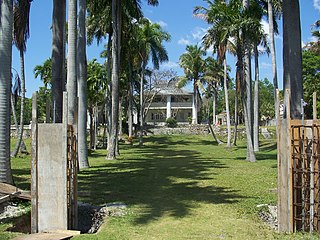
The Trapp Homestead is a historic home in the Coconut Grove section of the City of Miami, Florida, United States. It is located at 2521 South Bayshore Drive. On November 10, 1994, it was added to the U.S. National Register of Historic Places. The home was constructed in 1887 out of oolitic lime quarried locally by Caleb Trapp and his son, Harlan. During construction, the Trapps lived on a thatched hut at the front of the property. The property is believed to be the oldest-standing masonry home in Miami-Dade County, Florida. The estate's construction pre-dates the incorporation of the City of Miami. The estate was particularly notable at the time because it was one of the few stone structures in Miami-Dade County, as nearly all structures in the area were built of wood at that time.

The Coconut Grove Playhouse was a theatre in the Coconut Grove neighborhood of Miami, Florida, United States. The building was originally constructed as a movie theater called the Player's State Theater. It opened on January 1, 1927, as a part of the Paramount chain. The movie house was designed by the architect Richard Kiehnel of Kiehnel and Elliott. It was built by local realtors Irving J. Thomas and Fin L. Pierce. Albert Peacock was the contractor.

The Miami-Dade Public Library System (MDPLS) is a system of libraries in Miami-Dade County, Florida.
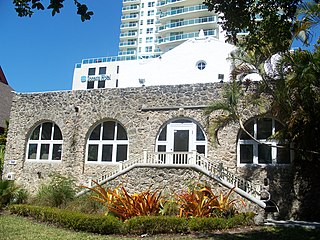
The Woman's Club of Coconut Grove is a historic woman's club in Miami, Florida.

Miami-Dade County is a county located in the southeastern part of the U.S. state of Florida. The county had a population of 2,701,767 as of the 2020 census, making it the most populous county in Florida and the seventh-most populous county in the United States. It is Florida's third largest county in terms of land area with 1,946 square miles (5,040 km2). The county seat is Miami, the core of the nation's ninth-largest and world's 65th-largest metropolitan area with a 2020 population of 6.138 million people, exceeding the population of 31 of the nation's 50 states as of 2022.

The architectural firm of Kiehnel and Elliott was established in Pittsburgh, Pennsylvania, in 1906. The firm did substantial work in Florida, and moved to Miami in 1922. From 1926, it was known as Kiehnel, Elliott and Chalfant.

Miami-Dade County Public Schools (M-DCPS) is the public school district serving Miami-Dade County in the U.S. state of Florida. Founded in 1885, it is the largest school district in Florida, the largest in the Southeastern United States, and the third-largest in the United States with a student enrollment of 356,589 as of August 30, 2021.
The following is a timeline of the history of the city of Miami in Miami-Dade County, Florida, United States.

Miami City Hall is the local government headquarters for the City of Miami, Florida. It has been located in the former Pan American Airlines Terminal Building on Dinner Key, which was designed by Delano & Aldrich and constructed in 1934 for the former International Pan American Airport, since 1954. The city's government headquarters originated in Downtown Miami for 58 years until its relocation to Coconut Grove.
